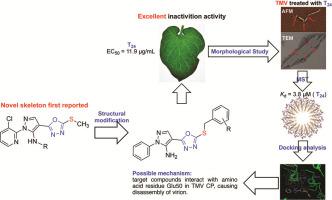Pesticide Biochemistry and Physiology ( IF 4.2 ) Pub Date : 2021-01-09 , DOI: 10.1016/j.pestbp.2021.104771 Zhibing Wu , Wenqing Yang , Shuaitao Hou , Dewen Xie , Jingxin Yang , Liwei Liu , Song Yang

|
A series of novel 1-phenyl-5-amine-4-pyrazole thioether derivatives containing a 1,3,4-oxadiazole moiety was designed and synthesised. In vivo antiviral bioassay results showed that most of the target compounds exhibited excellent inactivation activity against Tobacco mosaic virus (TMV). The EC50 values of the inactivation activities for T2, T7, T9, T24, T25 and T27 were 15.7, 15.7, 15.5, 11.9, 12.5 and 16.5 μg/mL, respectively, which were remarkably superior over that of the commercialised antiviral agent ningnanmycin (40.3 μg/mL). Morphological study using AFM and TEM of TMV treated with T24 showed that T24 could significantly shorten the polymerization length of TMV particles and formed a distinct break on the rod-shaped TMV. Investigations for virus infection efficiency on tobacco leaves demonstrated that infectivity of virion had been reduced obviously upon T24 treatment. Subsequently, a strong interaction between T24 and TMV-CP (Kd = 3.8 μM, score 6.11) was observed through MST experiments. Molecular docking study further revealed that target compounds interact with amino acid residue Glu50 in TMV CP, causing disassembly of virion, shorting the length of the virion and reducing the infectivity of virion, and resulting in high inactivating activity of target compounds. This study provides a new insight for discovery of antiviral compounds through a new action mechanism with a new binding site.
中文翻译:

新型1-苯基-5-胺-4-吡唑硫醚衍生物对烟草花叶病毒的体内抗病毒活性和拆解机理
设计并合成了一系列含有1,3,4-恶二唑部分的新型1-苯基-5-胺-4-吡唑硫醚衍生物。体内抗病毒生物测定结果表明,大多数目标化合物对烟草花叶病毒(TMV)表现出出色的灭活活性。T 2,T 7,T 9,T 24,T 25和T 27的灭活活性的EC 50值分别为15.7、15.7、15.5、11.9、12.5和16.5μg/ mL,明显优于商品化的抗病毒剂宁南霉素(40.3μg/ mL)。使用AFM并用TMV的TEM形态学研究Ť 24表明,Ť 24可以显著缩短TMV颗粒的聚合长度和形成在棒状TMV一个明显的中断。对烟草叶片上病毒感染效率的研究表明,在T 24处理后,病毒体的感染力已明显降低。随后,T 24与TMV-CP(K d 通过MST实验观察到= 3.8μM,得分6.11)。分子对接研究进一步揭示了目标化合物与TMV CP中的氨基酸残基Glu50相互作用,引起病毒体的分解,缩短了病毒体的长度并降低了病毒体的感染性,并导致目标化合物的高灭活活性。这项研究为通过具有新结合位点的新作用机制发现抗病毒化合物提供了新的见解。

































 京公网安备 11010802027423号
京公网安备 11010802027423号